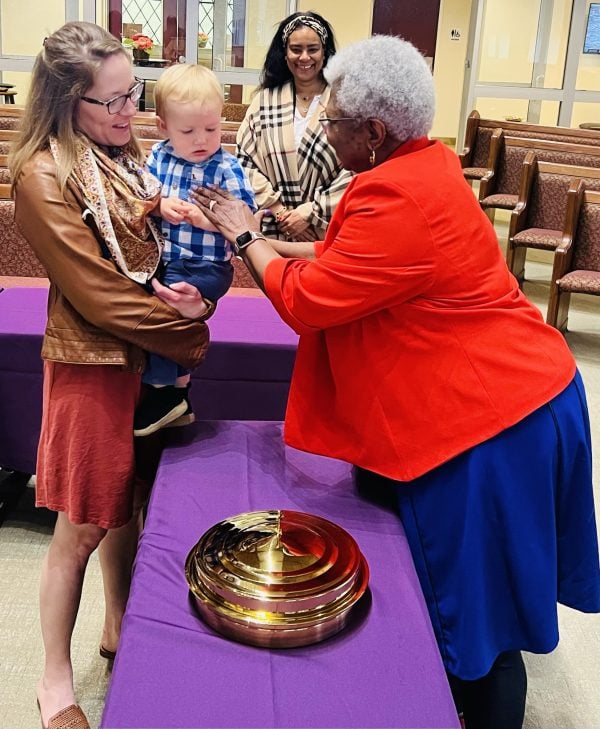Pass the trays? This congregation prefers gathering around the table

ARLINGTON, VA. — It’s warm and personal.
It’s close-knit like a real family.
That’s how Ernestine Jones, 77, a longtime member of the Arlington Church of Christ, describes the Washington, D.C.-area congregation’s new approach to communion.
“You actually get to see the person right in front of you,” said Jones, a retired federal government worker.
Ernestine Jones, right, greets Lindsey Smith and her son, Ansel, as church members gather around the communion tables.
Since the COVID-19 pandemic, the 85-year-old congregation — just across the Potomac River from the nation’s capital — has strived to make the Lord’s Supper more meaningful.
Church members no longer sit with heads bowed as they partake of the emblems.
In fact, the congregation — formed in the World War II era — removed entire rows of pews at the center of the auditorium. That modification made room for simple rectangular tables.
On a recent Sunday, nine gold communion trays rested atop purple tablecloths, providing a colorful backdrop for the commemoration of Jesus’ death, burial and resurrection.
Minister Chess Cavitt preached a message emphasizing the importance of the Lord’s Supper before worshipers — about 50 in all — rose from their seats and gathered on all sides of four tables.
Believers greeted fellow Christians with handshakes and hugs — and gazed into each other’s eyes as they ate of the bread and drank of the cup.
“We’re about to have a meal together,” the communion leader explained. “Granted, the portions may seem rather small, but the meaning is hugely significant.”
The outside of the Arlington Church of Christ building, just across the Potomac River from the nation’s capital.
‘Joyous communal meal’
In the 2008 book “Come to the Table: Revisioning the Lord’s Supper,” Restoration Movement scholar John Mark Hicks asserted that the “Christian practice of the Lord’s Supper as a silent, solemn, individualistic eating of bread and drinking of wine is radically dissimilar from the joyous communal meal in earliest Christianity.”
“I do affirm Word and Table as important and essential,” Hicks said in a Facebook message. “The Word as gospel proclamation explains the Table, and the Table is the experience of the gospel. The Table, in my view, is the climactic point of the assembly where we commune with God and each other. So, the sermon leads to the table, and the table is concrete visible communion with God and each other.”
Hicks’ perspective resonates with Cavitt, 38, a native Texan who earned undergraduate and graduate degrees from Abilene Christian University.
“I arrange my sermons to always feed directly into communion,” the minister said.
Daniel E. Holland, right, smiles as he stands beside church member Donnis Crump during the Lord’s Supper.
‘Why don’t we come around the table?’
The Arlington church hosts separate English and Spanish assemblies that once drew a combined crowd of about 250.
But after months of online worship during the pandemic, in-person attendance failed to return to normal. Some long-distance commuters found online services more convenient than driving to the building.
For those who did reconvene, social distancing and prepackaged individual communion cups were the new normal.
But after a while, “the elders decided that it was time to not be so afraid anymore,” said Lou Hoffman, 75, a longtime member.
Hoffman had an idea that she discussed with a former elder, Scott Brunner, before he moved to Alabama.
“Why don’t we come around the table rather than passing the trays?” she recalled asking.
Brunner replied that he had a similar thought.
Church member Lou Hoffman prepares the communion emblems for the Arlington Church of Christ.
‘A much more intimate thing’
At first the church tried a row of tables up front, but that became a bit unwieldy.
Then Cavitt suggested taking out the pews in the center of the auditorium — no longer needed with fewer in attendance — and the other leaders agreed.
The updated technique breaks up the routine of congregants sitting in worship and staring at the speaker or hymn lyrics on the screen, said elder Lance Baxter, an Air Force Academy graduate who has served in active duty and as a Pentagon civilian employee.
Elder Lance Baxter leads singing at the Arlington Church of Christ.
“As shepherds, we identified connection as one of the challenges our congregation faces,” Baxter said. “In Scripture, they gathered, and they broke bread, and it was a much more intimate thing, right?”
Hoffman, a retired federal government attorney, said she believes the new configuration has successfully brought the congregation closer together.
“It’s one of the most important parts of our gathering together,” she said of the Lord’s Supper. “In the Bible, that’s the reason they were getting together … and then they took advantage of that (time) to preach and sing and do the other things.”
Cavitt put it this way: “The idea was that communion should be a moment of communing, and if we’re all staring at our feet quietly, that doesn’t really work.”
The Arlington church’s new approach, he believes, better resembles what God intended.
“The idea was that communion should be a moment of communing, and if we’re all staring at our feet quietly, that doesn’t really work.”
BOBBY ROSS JR. is Editor-in-Chief of The Christian Chronicle. Reach him at [email protected].
Welcome to Billionaire Club Co LLC, your gateway to a brand-new social media experience! Sign up today and dive into over 10,000 fresh daily articles and videos curated just for your enjoyment. Enjoy the ad free experience, unlimited content interactions, and get that coveted blue check verification—all for just $1 a month!
Account Frozen
Your account is frozen. You can still view content but cannot interact with it.
Please go to your settings to update your account status.
Open Profile Settings